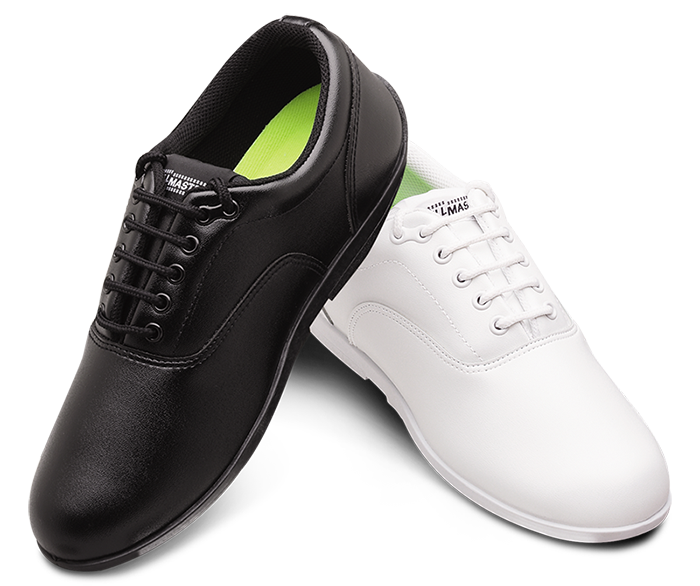From idea to best seller.
Sometimes called the "Father of the Modern Marching Shoe," Jon Farbman had not initially set out to become a shoe designer. In fact, Farbman began his University career at Cornell as an Engineering major but quickly moved on to Arts and Sciences in his sophomore year to study Astrophysics. After graduation, Farbman began work at Mission Control with NASA in Houston during the "Space Race" era of the 60s.
Following the Apollo 1 disaster, Farbman left the Aerospace industry. This began a decade of career changes, including Wall Street as a stockbroker for E. F. Hutton, a mechanic at a luxury auto repair shop, an amateur racecar driver (in a Lotus 7 race car that he built himself), a mechanical contractor and plumber for New York hospitals and subway system, and professional racecar driver.
Through all this – one thing remained constant: Jon's love of this classical music. A love his mother seeded at the age of 6 while he was recovering from mononucleosis. In fact, Farbman's love of music launched his career in advertising with Scali, McCabe, and Sloves (one of the top agencies in the world at the time).
High-fidelity music systems were cutting edge in the 70s, and Farbman used these systems to enjoy classical music. He also knew that one of the most critical parts of auto racing was the roar of the engines. So, Farbman reasoned, Pioneer High Fidelity Electronics would make the ideal sponsor for his auto racing team. He approached SMS with his idea. While he wasn't successful in landing a sponsor, they were still impressed. In 1978 Farbman was hired into a management position and soon began working with their creative team as a writer.
In 1984, Farbman became a casualty of the SMS agency's takeover. It was a tremendous upheaval, but it left him free to pursue his first love – not as a musician but as a sort of "groupie" touring cross-country with Drum and Bugle Corps during summer competitions. Farbman was so fascinated with the activity that he decided to write a movie. He did extensive research but never made the film.
Farbman had a eureka moment!
DRILLMASTERS
After all that touring, he found that musicians often expressed dissatisfaction with one thing: how unsuitable their shoes were for marching, sharing horror stories of debilitating blisters and injuries.
Sensing an opportunity to accommodate the needs of an underserved market, Farbman set out to create a, then, non-existent product -- comfortable marching band shoes with dance-shoe-like flexibility but durable enough to stand up to the rigors of corps-style marching.
The first Drillmasters underwent several revisions during development; initially prototyped as a high-top boot, these shoes were fondly dubbed the "Smurf boot." Drum corps groups loved the ankle-protecting design, but high school band directors weren't as convinced, so Farbman returned to the drawing board. And after some trial and error came a dress shoe-style sneaker. But not just any sneaker; this shoe came with a few secret weapons.
Farbman gave the shoe design a unique Rolled Heel™ that allowed students to learn proper marching form. He also gave them a Spat-Notch™ to keep spat straps securely in place, protected from wear and tear. A pivot circle focused just beneath the ball of the foot and twin soles would give them the flexibility of a dance shoe, perfect for complex choreography. Synthetic vegan leather and a non-slip sole would make them great for marching in all weather. And finally, padded ankle collars, a heel-lock lacing system, and an absorbent heel-to-toe lining would give the shoe the comfort of a high-quality running shoe.
Farbman launched the first official Drillmasters Shoe in 1985.
And it was a hit!
Students loved the comfort (and they certainly didn't miss the blisters), and directors loved the new teaching tool. These features were so crucial to marching shoe design that they have become nearly ubiquitous.
SPEEDSTERS
Soon, Farbman expanded the Drillmasters family to include a more budget-friendly version of the original. Initially retailing as the least expensive marching shoe on the market, the Speedsters kept some of the most critical features of the Drillmasters – durability, flexibility, all-weather construction, padded ankle collars, a heel-lock lacing system, and absorbent heel-to-toe lining – while also maintaining the sleek silhouette for a formal shoe.
SUPER DRILLMASTERS
In 2008, Farbman added a third to the Drillmasters product line, Super Drillmasters. The design of the Super Drillmaster was an intimate collaboration with the World Class DCI Champions, the Blue Devils Performing Arts that first began in 1994. The idea was born of a partnership of engineering and experience to create an upgraded version of the Drillmasters design that catered to the rigors of a world-class DCI show.
With input from the Drum Corps group, the design team maintained strict requirements for comfort, support, flexibility, and all-critical – safety and stability. The result was a marching shoe/dance shoe hybrid.




